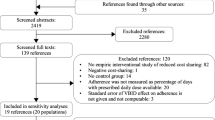Abstract
This article deals with the question of how to handle costs to enhance medication adherence in trial-based pharmacoeconomic analyses. It argues that resources to improve patient adherence have a clearly distinguishable impact on costs and utility and thus are relatively easy to exclude when transferring trial-based pharmacoeconomic analyses to clinical practice. It proposes a model that adjusts trial-based incremental costs and effectiveness for lower medication adherence in clinical practice. It shows that, contrary to conventional wisdom, drug cost effectiveness in clinical practice can be better than in clinical trials. This may have implications for policy recommendations, depending on how close trial-based cost effectiveness is to the maximum willingness to pay. In many situations, the adjustment may not result in a change in policy recommendations.
Similar content being viewed by others
References
Robiner WN. Enhancing adherence in clinical research. Contemp Clin Trials 2005; 26 (1): 59–77
Pablos-Mendez A, Barr RG, Shea S. Run-in periods in randomized trials: implications for the application of results in clinical practice. JAMA 1998; 279: 222–5
Mihalko SL, Brenes GA, Farmer DF, et al. Challenges and innovations in enhancing adherence. Control Clin Trials 2004; 25 (5): 447–57
Balkrishnan R. The importance of medication adherence in improving chronic-disease related outcomes: what we know and what we need to further know. Med Care 2005; 43: 517–20
Glasser SP. Clinical trials. In: Glasser SP, editor. Essentials of clinical research. Dordrecht: Springer, 2008: 39
Dunn G, Maracy M, Dowrick C, et al. Estimating psychological treatment effects from a randomised controlled trial with both non-compliance and loss to follow-up. Br J Psychiatry 2003; 183: 323–31
Hughes DA, Bagust A, Haycox A, et al. The impact of noncompliance on the cost-effectiveness of pharmaceuticals: a review of the literature. Health Econ 2001; 10 (7): 601–15
Cutler DM, Rosen AB, Vijan S. The value of medical spending in the United States, 1960–2000. N Engl J Med 2006; 355 (9): 920–7
Di Matteo MR, Giordani PJ, Lepper HS, et al. Patient adherence and medical treatment outcomes: a meta-analysis. Med Care 2002; 40: 794–811
Domino ME, Burns BJ, Silva SG, et al. Cost-effectiveness of treatments for adolescent depression: results from TADS. Am J Psychiatry 2008; 165 (5): 588–96
March J, Silva S, Petrycki S, et al. Fluoxetine, cognitivebehavioral therapy, and their combination for adolescents with depression: Treatment for Adolescents With Depression Study (TADS) randomized controlled trial. JAMA 2004; 292 (7): 807–20
Navarro R, Valler WE, Spangler M. Antidepressant utilization in managed care: an evaluation of SSRI use in two HMO settings. Med Interface 1995; 8 (8): 114–9, 123
Revicki DA, Brown RE, Keller MB, et al. Cost-effectiveness of newer antidepressants compared with tricyclic antidepressants in managed care settings. J Clin Psychiatry 1997; 58 (2): 47–58
Costello I, Wong IC, Nunn AJ. A literature review to identify interventions to improve the use of medicines in children. Child Care Health Dev 2004; 30 (6): 647–65
Peterson AM, Takiya L, Finley R. Meta-analysis of trials of interventions to improve medication adherence. Am J Health Syst Pharm 2003; 60 (7): 657–65
Payscale. Hourly rate survey report for certification: board certified pharmacotherapy specialist [online]. Available from URL: http://www.payscale.com/ [Accessed 2009 May 25]
Andrews G. Placebo response in depression: bane of research, boon to therapy. Br J Psychiatry 2001; 178: 192–4
McCombs JS, Nichol MB, Stimmel GL, et al. The cost of antidepressant drug therapy failure: a study of antidepressant use patterns in a Medicaid population. J Clin Psychiatry 1990; 51 Suppl.: 60–9
Mauskopf JA, Simon GE, Kalsekar A, et al. Nonresponse, partial response, and failure to achieve remission: humanistic and cost burden in major depressive disorder. Depress Anxiety 2008; 26 (1): 83–97
Mason J, Freemantle N, Nazareth I, et al. When is it costeffective to change the behavior of health professionals? JAMA 2001; 286 (23): 2988–92
Gandjour A, Lauterbach KW. When is it worth introducing a quality improvement program? A mathematical model. Med Decis Making 2003; 23 (6): 518–25
Gandjour A, Lauterbach KW. How much does it cost to change the behavior of health professionals? A mathematical model and an application to academic detailing. Med Decis Making 2005; 25 (3): 341–7
Fenwick E, Claxton K, Sculpher M. The value of implementation and the value of information: combined and uneven development. Med Decis Making 2008; 28 (1): 21–32
Hoomans T, Severens JL, Evers SM, et al. Value for money in changing clinical practice: should decisions about guidelines and implementation strategies be made sequentially or simultaneously? Med Decis Making 2009; 29 (2): 207–16
Hughes DA, Cowell W, Koncz T, et al. Methods for integrating medication compliance and persistence in pharmacoeconomic evaluations. Value Health 2007; 10 (6): 498–509
Granger BB, Swedberg K, Ekman I, et al. Adherence to candesartan and placebo and outcomes in chronic heart failure in the CHARM programme: double-blind, randomised, controlled clinical trial. Lancet 2005; 366 (9502): 2005–11
Acknowledgements
The author thanks Guido Grass for valuable information on measures to improve patient adherence in clinical trials. No sources of funding were used to prepare this manuscript. The author has no conflicts of interest that are directly relevant to the content of this article.
Author information
Authors and Affiliations
Corresponding author
Rights and permissions
About this article
Cite this article
Gandjour, A. A Model to Transfer Trial-Based Pharmacoeconomic Analyses to Clinical Practice. Pharmacoeconomics 29, 97–105 (2011). https://doi.org/10.2165/11584220-000000000-00000
Published:
Issue Date:
DOI: https://doi.org/10.2165/11584220-000000000-00000




